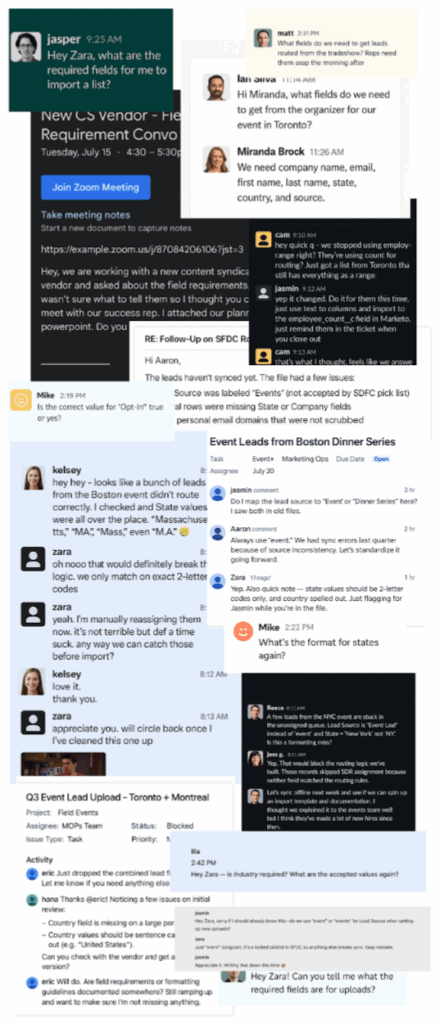Overview
Recently, I watched a documentary about quarterbacks and it reminded me of a viral clip of one of Joe Burrow’s wild play calls. They tend to go something like this:
“Pass 37 Punch Waggle Help Baby Dizzy X Fan On The Turbo”

It’s hilarious, but also a perfect example of alignment in action.
Every offensive player knows what to do. Not because the words make sense by themselves, but because their meaning is defined in the playbook allowing them to be on the same page. The call doesn’t live only in the QB’s head. It’s been documented, practiced, understood. Shared knowledge enables fast execution.
Now imagine a new player in that huddle with no playbook and no context. There’s no time to stop and explain what every play means before the snap. The play breaks down not because it is flawed, but because the system wasn’t shared. It was fully dependent on the existing players being there.
This is exactly what happens when GTM teams scale without making sure knowledge is shared and documented: Execution slows. Campaigns stall. Reporting gets fuzzy. What was once aligned becomes siloed. The people who hold the answers end up becoming blockers, not accelerators.
What Lack of Documentation Can Look Like
In business, alignment and documentation gaps can manifest differently based on organization complexity and role, but they impact everyone. Some are loud and disruptive. Others chip away quietly in the background.
- A new AE joins and has no idea why certain leads are assigned to them. Everyone they ask is too busy to explain or doesn’t know either.
- “Lead Source” keeps getting overwritten, but no one knows when or why. Everyone is nervous it was put in place for a reason and do not want to mess something up so no one does anything.
- A funnel report breaks but the only person who knows how to fix it left the company. This leaves multiple team members unprepared for an important meeting and scrambling.
- Event leads keep arriving dirty, and no one remembers the field requirements. Updates are time consuming and by the time leads get to sales, competitors have already gotten there first.
- A Salesforce field is syncing incorrectly, and the fix lives in a Slack thread from last year. Those trying to troubleshoot weren’t here at that time and don’t know the answer has already been found.
- A founding exec can’t make every call anymore, but no one else has the context or feels enabled to move a project forward.
Melissa Perri, speaking from her experience in the adjacent field of product ops, said it best: “If it’s not documented, you don’t have a process. You have a person.” A person being the single source of truth – whether a founder, CEO, sales manager, or marketing operations manager – does not scale in a high growth environment.
Why Orgs Should Document Early
If Burrow’s call at the line is what execution and alignment look like, the playbook is what makes it possible.
Later in the same documentary, two other starting quarterbacks, Jared Goff and Kirk Cousins, walk through their game prep. They watch film, align on terminology, and review documentation from previous matchups: what was called, what coverage they saw, why it worked, and where things broke down. They aren’t just reacting. They’re using documentation to align, plan, and improve.
That shared playbook isn’t just about the current plays. It’s also a record of how similar plays performed in the past, notes on why certain things are done the way they are and reminders of what worked, what didn’t, and why.
In many businesses though, unfortunately, this same kind of documentation is treated like a nice-to-have. Something to do once the real work is done. But without it, your GTM engine can’t scale. Everyone runs their own version of the play, alignment suffers and critical context gets lost.
If you’re building repeatable processes or even starting to think about scale, documentation isn’t extra. It’s the foundation. It:
- Turns institutional knowledge into shared systems
- Makes onboarding faster and handoffs smoother
- Reduces errors and miscommunication
- Helps teams make confident, informed decisions
- Demonstrates operational readiness to future investors
- Preserves the “why” behind key decisions
If you’re raising or preparing to, this matters more than you might think. Investors don’t just want revenue numbers. They want proof that your systems can scale without relying fully on the institutional knowledge of a few employees.
Documentation signals operational readiness. It shows that your GTM engine won’t stall the moment someone takes PTO. It proves your team isn’t running on memory, hallway conversations or slack threads but on process, clarity, and repeatability.

What to Document First
You’ve probably lived some version of the image above. While it is a fictional representation, it is something we see all the time in our work. If you’ve been the person on the receiving end of constant pings, you know exactly how quickly they add up. The Slack interruptions, the email chains, the manual rework. It doesn’t just waste time, it quietly chips away at alignment and clarity across your org.
If this sounds familiar, you’re definitely not alone. Forbes recently shared an internal study showing 71% of organizations surveyed have fewer than half of their business processes documented (via Forbes).
One of the easiest ways to start is by taking inventory. Figure out what documentation already exists, what’s outdated, and what’s missing altogether. Then look for the spots people hesitate, where answers vary depending on who you ask, or where something repeatedly breaks and gets patched instead of actually fixed.
Common areas teams often start with include:
- Field definitions and formatting rules that impact routing or reporting
- Lifecycle stages and the criteria for moving between them
- Lead assignment logic, including fallback rules
- Campaign setup: naming conventions, requirements, submission processes, and launch checklists
- Scoring models and clear thresholds for sales handoff
Make It Easy to Start
The biggest blocker to documentation is time. If it takes longer to write something down than to just do it again, many will choose the quicker route. So lower the barrier.
Take the Slack chaos above. Threads like that are prime candidates for AI support. Drop those messages into NotebookLM or ChatGPT and ask it to generate a first draft of your SOP.
Some other practical ideas to get started:
- A Loom walkthrough and a transcript
- Use Scribe to capture a process you find you repeatedly describe
- Use NotebookLM or ChatGPT to consolidate meeting notes, slack threads, and error logs into SOP documentation
- Turning a Slack thread into a short decision log
- Copying and pasting a checklist into a shared doc
- Using AI to turn rough notes into a draft someone can refine
You’re not aiming for perfection. You’re building a foundation. It’s easier to tighten up formatting later than to chase down answers that were never written down. Just start. Still stuck? We’ve compiled The Ultimate Marketing Ops Documentation Template to help.
Make It the Company Culture, Not a One Time Project
Documentation has to stay current or it loses value. That means building it into how your team works. It’s not a one-time project you check off the list.
Build habits like:
- Planning time for documentation into projects
- Updating docs when something changes
- Writing down decisions when they’re made
- Asking “where is this documented” in standups and project reviews
- Sharing links to documentation instead of explaining things twice
Pick tools and formats your team will actually use. Don’t overcomplicate it. Simplicity enables adoption. Encourage edits and updates from anyone who spots gaps. Shared ownership is what keeps documentation useful.







